Zanzibar: A Fragrant Journey
A few facts...
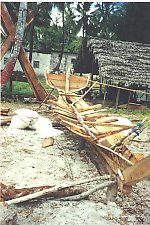 Zanzibar, locally called Unguja, but known to the 50,000 tourists that visit
annually as the "Spice Island", is the largest of several islands some
forty miles off the coast of E. Africa, and 6į south of the Equator. The island
is 85 Km. in length and varies in width between 20 and 30 Km. A sister island
called Pemba lies to the north, and it is here that much of the Clove industry
resides - in fact it now accounts for three-quarters of the areaís total
production. This has occurred because Pembaís climate is more suited to Clove
cultivation. Zanzibar has an interesting past, which tells tales of the
large-scale cultivation of Cloves and spices, and of Ivory and Slave Trading,
the latter finally ceasing in 1873. Its association with witchcraft (many say
Pemba is the home of Voodoo) is not a subject for easy discussion between
tourists and inhabitants. Zanzibar is now a semi-autonomous part of the United
Republic of Tanzania but has its own seat of government in Stonetown, the
islandís capital, and amongst other things, is responsible for Health,
Industry, Tourism, Agriculture, and Judicial matters. Zanzibar tries to uphold
Muslim sensibilities on matters such as dress codes in public places, it is a
pity that through ignorance or defiance, so many tourists offend by showing bare
flesh.
Zanzibar, locally called Unguja, but known to the 50,000 tourists that visit
annually as the "Spice Island", is the largest of several islands some
forty miles off the coast of E. Africa, and 6į south of the Equator. The island
is 85 Km. in length and varies in width between 20 and 30 Km. A sister island
called Pemba lies to the north, and it is here that much of the Clove industry
resides - in fact it now accounts for three-quarters of the areaís total
production. This has occurred because Pembaís climate is more suited to Clove
cultivation. Zanzibar has an interesting past, which tells tales of the
large-scale cultivation of Cloves and spices, and of Ivory and Slave Trading,
the latter finally ceasing in 1873. Its association with witchcraft (many say
Pemba is the home of Voodoo) is not a subject for easy discussion between
tourists and inhabitants. Zanzibar is now a semi-autonomous part of the United
Republic of Tanzania but has its own seat of government in Stonetown, the
islandís capital, and amongst other things, is responsible for Health,
Industry, Tourism, Agriculture, and Judicial matters. Zanzibar tries to uphold
Muslim sensibilities on matters such as dress codes in public places, it is a
pity that through ignorance or defiance, so many tourists offend by showing bare
flesh.
The island is fairly flat with only a few hills in central
and western parts. Rainy seasons are usually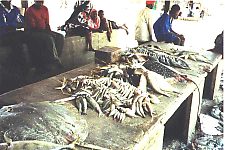 regarded as being from March to May, with the small rains in November, but
many locals say the November rains are not worth mentioning, as the changing
climate means that rain can fall virtually at any time. It is very hot and
humid! I was warned several times by locals not to rush around, and to slow down
to the Zanzibarian laid-back pace to avoid over-exertion! Vegetation is lush,
the island originally being covered in forest. Coral rag and sandy soil covers
much of the island, but red fertile iron-rich earth seems to be a feature of the
central parts. Mangroves, lagoons and coral reefs are all to be found in
Zanzibar. What the tourist guides may not tell you is that there is an algal
problem in the shallow seas, off the sea northern coast at least, and local
people have been told not to catch and eat the fish, to avoid becoming ill. Of
course, little notice is taken...
regarded as being from March to May, with the small rains in November, but
many locals say the November rains are not worth mentioning, as the changing
climate means that rain can fall virtually at any time. It is very hot and
humid! I was warned several times by locals not to rush around, and to slow down
to the Zanzibarian laid-back pace to avoid over-exertion! Vegetation is lush,
the island originally being covered in forest. Coral rag and sandy soil covers
much of the island, but red fertile iron-rich earth seems to be a feature of the
central parts. Mangroves, lagoons and coral reefs are all to be found in
Zanzibar. What the tourist guides may not tell you is that there is an algal
problem in the shallow seas, off the sea northern coast at least, and local
people have been told not to catch and eat the fish, to avoid becoming ill. Of
course, little notice is taken...
Flora and fauna
The rare Red colobus monkeys Procolobus kirkii are now protected
in Jozani forest reserve, which lies a little South of the islandís centre.
Their diet includes the introduced tree the Red Mahogany, better known by
its botanical name Calophyllum inophyllum, the extracts from
which, ironically enough, are much in demand by phyto-aromatherapists word-wide.
This tree remains unexploited in Zanzibar for trade purposes however. Civet cats
are also said to roam the reserve, but I was not lucky enough to see any!
Other introduced plants include the Neem tree Azadichirachta
indica and the Caribbean pine Pinus caribaea, as well as two
Eucalypts Eucalyptus camaldulensis and E. terricornis, but
it is another introduced Australian species Causarina equisetifolia which
can be seen successfully growing all over the island. This species has the
appearance of a typical pine tree, and its red wood is cut and used for poles
and roofing materials. The Soapberry tree, Sapindus saponaria
grows to 15m. and is native to tropical America, but you find it growing
throughout Zanzibar. The berries are collected by local people, for trade and
for personal use, as they produce a frothy lather when macerated with water, and
can be used to wash the body or clothes.
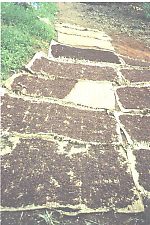 Cloves
(Syzygium aromaticum) have a long history of association with Zanzibar,
being considered the finest quality from this origin. Introduced in 1818 from
the Seychelles & Mauritius, Sultan Said (Sultan from 1804-1856), of Omanís
Abusaid Dynasty, is credited with making Zanzibar the worldís major clove and
spices producer, setting up clove plantations which produced 35,000 metric tons
in 1834, and controlled 90% of the world market. It is interesting to reflect
that at this stage, island generated so much wealth, riches, yet today its
peoples live largely in abject poverty. Returning to the theme, today only
seaweed farms (largely worked by local women, and growing Euchema spinosum and
E. cottoni to produce gel products for food & cosmetic uses) and tourism
compete with the clove industry as a money-earner.
Cloves
(Syzygium aromaticum) have a long history of association with Zanzibar,
being considered the finest quality from this origin. Introduced in 1818 from
the Seychelles & Mauritius, Sultan Said (Sultan from 1804-1856), of Omanís
Abusaid Dynasty, is credited with making Zanzibar the worldís major clove and
spices producer, setting up clove plantations which produced 35,000 metric tons
in 1834, and controlled 90% of the world market. It is interesting to reflect
that at this stage, island generated so much wealth, riches, yet today its
peoples live largely in abject poverty. Returning to the theme, today only
seaweed farms (largely worked by local women, and growing Euchema spinosum and
E. cottoni to produce gel products for food & cosmetic uses) and tourism
compete with the clove industry as a money-earner.
Clove buds are hand-picked when green, separated from their
stems, and can be seen (and smelled!) drying out and turning brown in the sun on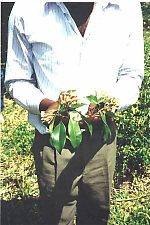 mats by the roadside in many parts of the island; however there are some
problems with the industry. The government monopoly which buys cloves from local
farmers (The Zanzibar State Trading Corp.) pays a low price, and coupled with
the problems of viral diseases which have blighted crops in certain years, many
farmers have chopped the trees down to sell for firewood, or actually burnt them
to the ground in disgust. Smuggling cloves to Kenya & Tanzania can realize
twice the value which the State Trading Corporation will pay, but there is often
little in it for the farmers, who see little of the extra money.
mats by the roadside in many parts of the island; however there are some
problems with the industry. The government monopoly which buys cloves from local
farmers (The Zanzibar State Trading Corp.) pays a low price, and coupled with
the problems of viral diseases which have blighted crops in certain years, many
farmers have chopped the trees down to sell for firewood, or actually burnt them
to the ground in disgust. Smuggling cloves to Kenya & Tanzania can realize
twice the value which the State Trading Corporation will pay, but there is often
little in it for the farmers, who see little of the extra money.
Clove stems are separately collected and sent to Pemba for distillation,
following closure of the stem oil distillery in the docks area of Stonetown. An
sample of this oil brought back by the author, was found to have the following
composition:
Clove Stem Oil Zanzibar
 The influence of some of these above components on the odour profile of clove
oil can be found in Natural Aromatic Materials: Odours & Origins
written by the author advertised elsewhere on this site.
The influence of some of these above components on the odour profile of clove
oil can be found in Natural Aromatic Materials: Odours & Origins
written by the author advertised elsewhere on this site.
Other Spices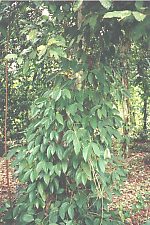
Other spices that are found on the island include the Cardamom Elletaria
cardamomum and False cardamom Afromomum angustifolium, the
Pepper Vine Piper nigrum and Turmeric Curcuma longa.
The Curry-leaf plant Murraya koenigii was
especially fascinating to me: being incredibly pungent (in contrast to the only
mildly spicy essential oil). It is used as incense, the smoke apparently reputed
to keep devils away from children.
Cinnamom (Cinnamomum camphora) & Nutmeg trees
(Myristica fragrans: whose products are occasionally used as
psycho-active agents by the Zanzibarians, are not uncommon on the island. [As a
rider to this, in my conversations with farmers, many males privately professed
worries about the fact that nutmeg taking (to get high) was a particular problem
amongst local women on the island].
Lemongrass (Cymbopogon citratus) from plants
brought over from Africa also thrives here, and is used locally to flavour
dishes and beverages.
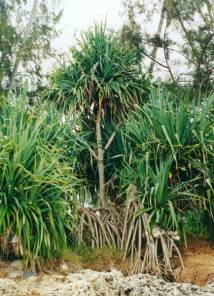 Fragrant flowers
Fragrant flowers
Pandanus, or Screw Pine Pandanus kirkii is a tree that is often
seen on the coastal margins of the island, above the high-tide mark. The trees
have thin sword like leaves up to 1m. long, sprouting from the branch-ends, and
roots hang down from various parts of the trunk to anchor the tree against
storms. It is the fragrant male flowers, which are on separate spikes from the
females, which are fascinating, being much sought after for their perfume. In N.
India the sweet distillation water from male flowers of P. odaritissimus L.
is used to flavour confectionery, and an attar is made by condensing
distillation vapours into cooled sandalwood oil. Other fragrant flowers include frangipani
trees, many of which can grow to a considerable size and whose white flowers
tinged with orange-yellow appear when the tree is not in leaf, making an amazing
site against the black-brown limbs of the tree in the capitalís streets. My
attempts to take pictures of the green or yellow petalled Mkilua fragrans
plant came to nothing, but garlands are made form flowers of these plants to be
worn by guests at wedding ceremonies. Together with Jasmine, Ylang-ylang and
Frangipani, and the red flowers of the naturalised Flame tree Delonix
regia, a perfumed paradise is present here!
Useful Plants
The Iodine Plant Jatropha multifida (syn. Adenoropium
multifidum Pohl.) is a shrub (which can exceptionally grow to the
dimensions of a small tree, up to 7m.) which is native to Central America but
has become naturalised on Zanzibar. It is used medicinally by the local people,
who use it to disinfect and help heal wounds, by snapping off the leaves from
the main stems, and dripping the latex which issues out, onto the affected area.
Imagine a citrus drink which tastes like oranges and passion fruit, but comes
from the fruits of a liana named the Rubber Vine (!) Saba comorensis (Bojer)
Pichon. The local name for the drink is Mbungo, (tourists corrupt this to
"bongo juice"!) and many bars on the island will sell you this
delicious drink! Unfortunately I wasnít able to sample a decoction of the
bark, locally famed as an aphrodisiac! Other fruit available on the island
includes Mango (Mangifera indica) from trees that are widespread
on the island, the tree also being used for its wood, Star-fruit (Averrhoa
carambola), Shaddock (Citrus maxima), Soursops (Annona
muricata), jack-fruit (Artocarpus heterophyllus) and bananas
(Musa paradisiaca). I am sure I have missed others!
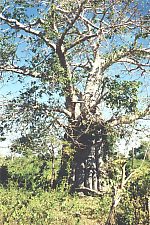
It was fascinating for a UK dweller like me to see the tall Kapok tree Ceiba
pentandra, the products from which are used to stuff mattresses &
pillows. This tree is related to the "upside down tree" or the Boabab
Adansonia digitata which also dramatically enhance the landscape, and a
leaf decoction from this tree is used to treat malaria, which is rife in this
area. It is estimated that one third of the local population will succumb to
this terrible disease, and talking to the local people it is obvious that there
is little knowledge of the mosquito as the vector of the disease, or how to
eradicate it from its breeding grounds. Nor need we Westeners feel superior
either, since I discovered that the anti-malarial tablets that my UK medical
practice had prescribed for me (chlorquine) had not worked against local strains
of the disease in Zanzibar and Tanzania for the last 20 years! Unfortunately
this fact had not filtered back to our medical community. Mosquitoes also spread
filariasis (elephantiasis) which sadly has affected many people in the south of
the island.
Coconut oil from the trees of Cocos
nucifera, which are often planted in between rows of clove trees, are used
by locals to make soap, and very small local businesses make this item to supply
shops and markets in Stonetown. In particular I purchased some very good clove
soap (used as an insect repellent) and some beautiful Ylang-ylang soap
from a Stonetown stall-holder, made by a womenís group from locally collected
flowers just west of the northerly tip of the island. It would be very
satisfying to be able to trade with these small producers, but I was informed
that the reality is that any whiff of export success would be met with punitive
taxation by the authorities... Finally the lipstick plant Bixa orellana
(Annato) was another thrill for me to see: splitting open the red fruits reveals
waxy seeds from which a red pigment issues forth, which is used world-wide as a
food colouring.
I left Zanzibar with mixed feelings. For the privileged it is a relatively
unspoiled paradise. It clearly will not remain that way for long, and tourism
will not benefit the ordinary people and the smallholders. Many hotel jobs go to
better educated Tanzanians rather than people born on Zanzibar or Pemba, and
hotel-lobbies are full of American, English and Dutch entrepreneurs organizing
package tours on the hoof. Because of the outcome of the last two elections,
where according to news reports, boatloads of people were bought over from Dar-es-Salam
to rig the voting, foreign aid has been denied. Whilst this may be seen as a
grandiose retaliatory measure against certain corrupt officials, the only people
it really hurts are the endemic population, who have done nothing wrong, and
still remain largely uneducated, battling disease, and in abject poverty.
In 1994 Amir A. Mohammed wrote a very moving book1
about the plight of his people. I am going to quote a small piece from this book
without permission, but I believe he wonít mind because we are united in a
common humanitarian purpose:
"There is an urgent need for the island to establish a research centre
in order to exploit the vast potential of our herbs, leaves, fruits, barks and
roots of our trees and shrubs top produce a variety of medicines.. I believe if
this idea is put into action, we may one day come up with new ways of building
health of our people through our own effort".
The above is a very fine idea. Zanzibar isnít a trendy producer of natural
products like Corsica or Madagascar however, but it does have fine quality
products to offer, and it needs the trade. If someone reading this out there in
cyberland has any ideas on how to help to improve the lot of the peoples there,
please contact the author!
1Amir A. Mohammed Zanzibar,
Facts Figures & Fiction Alkhayria Press Ltd., Zanzibar (1994).
List of illustrations in descending order:
- Boat buidling at Nunghi.
- Fresh fish market at Chwaka on the east coast.
- Cloves drying by roadside on mats.
- Picked clove buds.
- Pepper vine Piper
nigrum
- Screw thatch pine Pandanus kirkii at Nunghi.
- One of several Boabab trees pictured in the North of
the island.
BACK TO
MAGAZINE
Copyright © 2000 by Tony Burfield All Rights reserved
 Zanzibar, locally called Unguja, but known to the 50,000 tourists that visit
annually as the "Spice Island", is the largest of several islands some
forty miles off the coast of E. Africa, and 6į south of the Equator. The island
is 85 Km. in length and varies in width between 20 and 30 Km. A sister island
called Pemba lies to the north, and it is here that much of the Clove industry
resides - in fact it now accounts for three-quarters of the areaís total
production. This has occurred because Pembaís climate is more suited to Clove
cultivation. Zanzibar has an interesting past, which tells tales of the
large-scale cultivation of Cloves and spices, and of Ivory and Slave Trading,
the latter finally ceasing in 1873. Its association with witchcraft (many say
Pemba is the home of Voodoo) is not a subject for easy discussion between
tourists and inhabitants. Zanzibar is now a semi-autonomous part of the United
Republic of Tanzania but has its own seat of government in Stonetown, the
islandís capital, and amongst other things, is responsible for Health,
Industry, Tourism, Agriculture, and Judicial matters. Zanzibar tries to uphold
Muslim sensibilities on matters such as dress codes in public places, it is a
pity that through ignorance or defiance, so many tourists offend by showing bare
flesh.
Zanzibar, locally called Unguja, but known to the 50,000 tourists that visit
annually as the "Spice Island", is the largest of several islands some
forty miles off the coast of E. Africa, and 6į south of the Equator. The island
is 85 Km. in length and varies in width between 20 and 30 Km. A sister island
called Pemba lies to the north, and it is here that much of the Clove industry
resides - in fact it now accounts for three-quarters of the areaís total
production. This has occurred because Pembaís climate is more suited to Clove
cultivation. Zanzibar has an interesting past, which tells tales of the
large-scale cultivation of Cloves and spices, and of Ivory and Slave Trading,
the latter finally ceasing in 1873. Its association with witchcraft (many say
Pemba is the home of Voodoo) is not a subject for easy discussion between
tourists and inhabitants. Zanzibar is now a semi-autonomous part of the United
Republic of Tanzania but has its own seat of government in Stonetown, the
islandís capital, and amongst other things, is responsible for Health,
Industry, Tourism, Agriculture, and Judicial matters. Zanzibar tries to uphold
Muslim sensibilities on matters such as dress codes in public places, it is a
pity that through ignorance or defiance, so many tourists offend by showing bare
flesh. regarded as being from March to May, with the small rains in November, but
many locals say the November rains are not worth mentioning, as the changing
climate means that rain can fall virtually at any time. It is very hot and
humid! I was warned several times by locals not to rush around, and to slow down
to the Zanzibarian laid-back pace to avoid over-exertion! Vegetation is lush,
the island originally being covered in forest. Coral rag and sandy soil covers
much of the island, but red fertile iron-rich earth seems to be a feature of the
central parts. Mangroves, lagoons and coral reefs are all to be found in
Zanzibar. What the tourist guides may not tell you is that there is an algal
problem in the shallow seas, off the sea northern coast at least, and local
people have been told not to catch and eat the fish, to avoid becoming ill. Of
course, little notice is taken...
regarded as being from March to May, with the small rains in November, but
many locals say the November rains are not worth mentioning, as the changing
climate means that rain can fall virtually at any time. It is very hot and
humid! I was warned several times by locals not to rush around, and to slow down
to the Zanzibarian laid-back pace to avoid over-exertion! Vegetation is lush,
the island originally being covered in forest. Coral rag and sandy soil covers
much of the island, but red fertile iron-rich earth seems to be a feature of the
central parts. Mangroves, lagoons and coral reefs are all to be found in
Zanzibar. What the tourist guides may not tell you is that there is an algal
problem in the shallow seas, off the sea northern coast at least, and local
people have been told not to catch and eat the fish, to avoid becoming ill. Of
course, little notice is taken... Cloves
(Syzygium aromaticum) have a long history of association with Zanzibar,
being considered the finest quality from this origin. Introduced in 1818 from
the Seychelles & Mauritius, Sultan Said (Sultan from 1804-1856), of Omanís
Abusaid Dynasty, is credited with making Zanzibar the worldís major clove and
spices producer, setting up clove plantations which produced 35,000 metric tons
in 1834, and controlled 90% of the world market. It is interesting to reflect
that at this stage, island generated so much wealth, riches, yet today its
peoples live largely in abject poverty. Returning to the theme, today only
seaweed farms (largely worked by local women, and growing Euchema spinosum and
E. cottoni to produce gel products for food & cosmetic uses) and tourism
compete with the clove industry as a money-earner.
Cloves
(Syzygium aromaticum) have a long history of association with Zanzibar,
being considered the finest quality from this origin. Introduced in 1818 from
the Seychelles & Mauritius, Sultan Said (Sultan from 1804-1856), of Omanís
Abusaid Dynasty, is credited with making Zanzibar the worldís major clove and
spices producer, setting up clove plantations which produced 35,000 metric tons
in 1834, and controlled 90% of the world market. It is interesting to reflect
that at this stage, island generated so much wealth, riches, yet today its
peoples live largely in abject poverty. Returning to the theme, today only
seaweed farms (largely worked by local women, and growing Euchema spinosum and
E. cottoni to produce gel products for food & cosmetic uses) and tourism
compete with the clove industry as a money-earner.  mats by the roadside in many parts of the island; however there are some
problems with the industry. The government monopoly which buys cloves from local
farmers (The Zanzibar State Trading Corp.) pays a low price, and coupled with
the problems of viral diseases which have blighted crops in certain years, many
farmers have chopped the trees down to sell for firewood, or actually burnt them
to the ground in disgust. Smuggling cloves to Kenya & Tanzania can realize
twice the value which the State Trading Corporation will pay, but there is often
little in it for the farmers, who see little of the extra money.
mats by the roadside in many parts of the island; however there are some
problems with the industry. The government monopoly which buys cloves from local
farmers (The Zanzibar State Trading Corp.) pays a low price, and coupled with
the problems of viral diseases which have blighted crops in certain years, many
farmers have chopped the trees down to sell for firewood, or actually burnt them
to the ground in disgust. Smuggling cloves to Kenya & Tanzania can realize
twice the value which the State Trading Corporation will pay, but there is often
little in it for the farmers, who see little of the extra money. The influence of some of these above components on the odour profile of clove
oil can be found in Natural Aromatic Materials: Odours & Origins
written by the author advertised elsewhere on this site.
The influence of some of these above components on the odour profile of clove
oil can be found in Natural Aromatic Materials: Odours & Origins
written by the author advertised elsewhere on this site.
 Fragrant flowers
Fragrant flowers